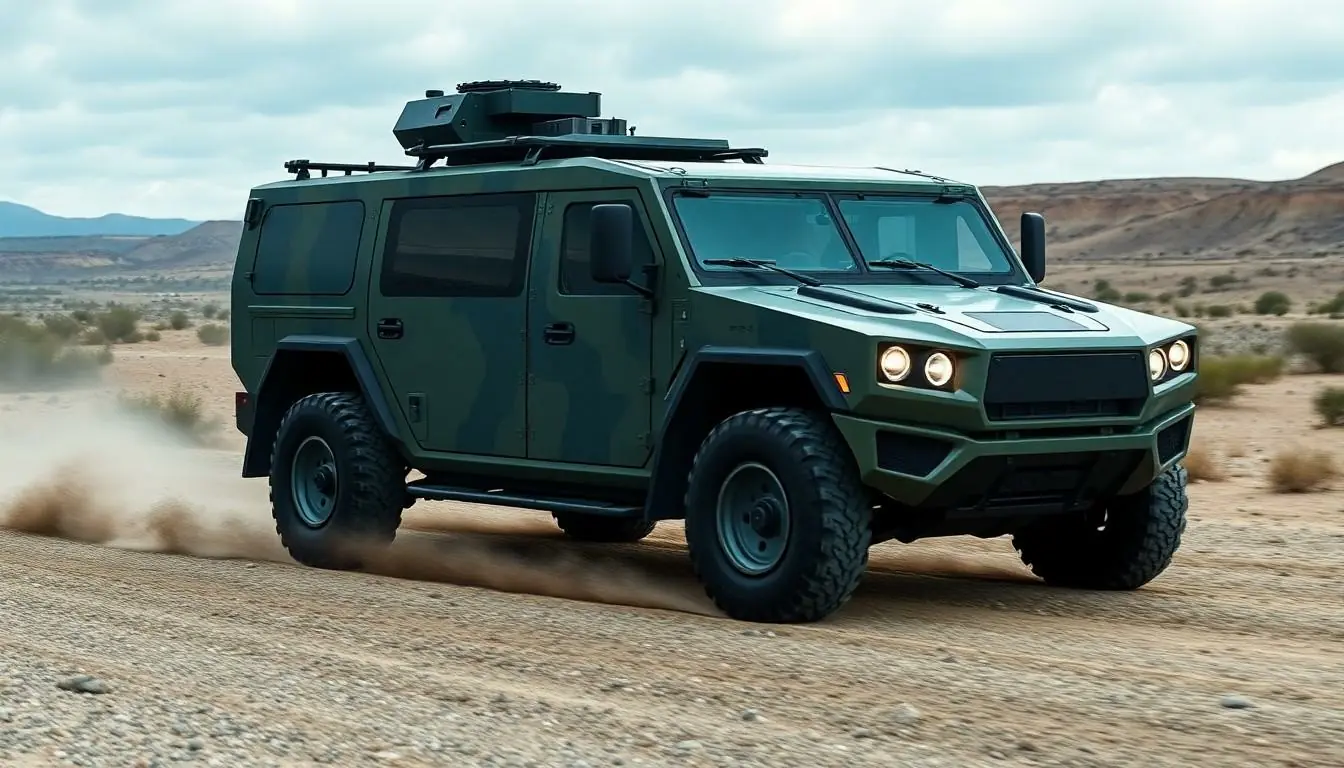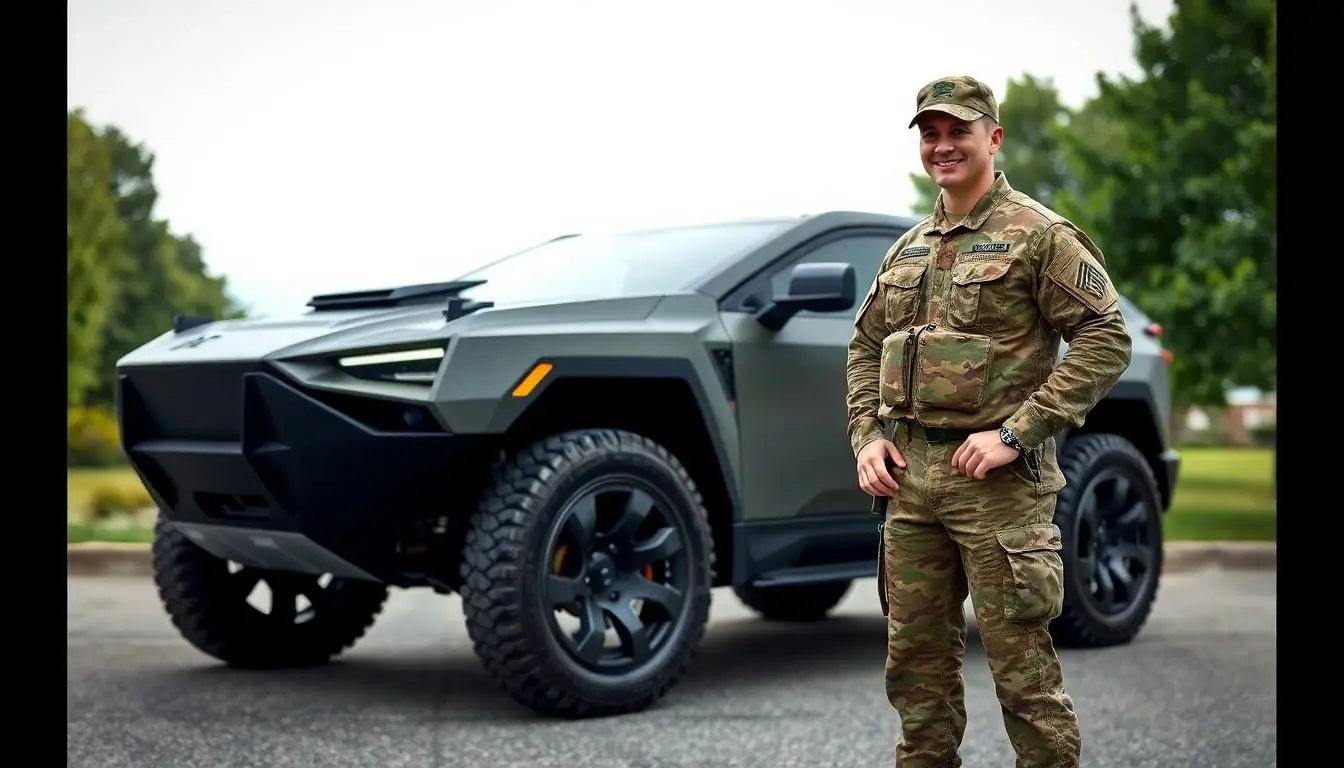In a world where electric cars zoom past gas-guzzlers, it’s time for the military to join the eco-friendly revolution. Enter electric military vehicles—where cutting-edge technology meets stealthy operations. These high-tech machines aren’t just about saving fuel; they’re about reimagining how armies operate on the battlefield. Who knew saving the planet could also mean outsmarting the enemy?
Picture this: a silent electric tank gliding through the night, leaving no trace of its presence. While traditional vehicles rumble and roar, these electric wonders sneak up like ninjas. With reduced emissions and lower operational costs, electric military vehicles are not just a trend; they’re the future of defense. As the military embraces this green shift, it’s clear that going electric isn’t just smart—it’s downright strategic.
Table of Contents
ToggleOverview of Electric Military Vehicles
Electric military vehicles are transforming defense strategies and operations. These vehicles feature advanced battery technology, allowing for silent movement and reduced heat signatures, which enhances stealth capabilities. Military branches are increasingly adopting electric options as they aim to reduce dependence on fossil fuels. Operational costs significantly decrease due to lower fuel consumption and maintenance requirements.
Designs for electric military vehicles include armored personnel carriers, tactical trucks, and even unmanned aerial vehicles. The U.S. Army’s Electric Light Reconnaissance Vehicle showcases how electric technology can provide mobility and versatility on the battlefield. Other examples include the British Army’s Multi-Role Vehicle, which is designed for various operational demands while being environmentally friendly.
Innovation plays a crucial role in the evolution of electric military vehicles. Research and development focus on improving battery life, charging times, and energy efficiency. Collaboration between military and commercial sectors aids in accelerating technological advancements. Data indicates that switching to electric can result in a 30% reduction in logistics costs over traditional vehicles.
Military analysts underline that electric vehicles also play a strategic role in operational readiness. Reliability during missions increases as these vehicles encounter fewer mechanical failures. Sustainability efforts, such as reducing carbon footprints, align with global defense initiatives aiming for greener practices. Electric military vehicles stand at the intersection of technology, strategy, and environmental responsibility, highlighting their growing importance in modern warfare.
Benefits of Electric Military Vehicles

Electric military vehicles offer significant advantages, enhancing both operational effectiveness and environmental responsibility. Their ability to operate with minimal emissions aligns with military goals to reduce environmental footprints and lower overall operational costs.
Environmental Impact
Electric military vehicles minimize greenhouse gas emissions by substituting traditional fossil fuels. Operational energy sources transition towards cleaner alternatives, promoting sustainability within military practices. As a result, reduced reliance on fuel not only cuts costs but also lessens air and noise pollution. With the development of electric vehicles, the military reinforces its commitment to eco-friendly initiatives without sacrificing performance. Military designs such as the U.S. Army’s Electric Light Reconnaissance Vehicle demonstrate this commitment by integrating advanced technology for greener operations.
Operational Efficiency
Enhanced reliability characterizes electric military vehicles, reducing mechanical failures. Advanced battery technology allows for extended operational ranges, making them suitable for diverse missions. Lower maintenance requirements contribute to cost savings over time, alongside decreased fuel consumption. Electric vehicles, like tactical trucks, increase operational readiness, which military analysts highlight as a crucial aspect of modern warfare. Ongoing research continues to push for better battery life, illustrating the military’s dedication to maximizing the effectiveness of electric systems.
Types of Electric Military Vehicles
Electric military vehicles come in various forms, adapting to specific operational needs while supporting a more sustainable defense strategy.
Electric Tanks
Electric tanks represent a significant advancement in armored combat versatility. These vehicles utilize electric propulsion systems, providing reduced noise levels and heat signatures, which enhances stealth capabilities. For instance, manufacturers focus on integrating advanced battery technologies to extend operational ranges while minimizing logistics for fuel supplies. The potential to incorporate renewable energy sources presents a strategic advantage on the battlefield. Military branches are currently testing prototypes like the silent electric tank, aiming for improved tactical efficiency.
Electric Trucks and Logistics Vehicles
Electric trucks and logistics vehicles play a vital role in military supply chains. Many operations benefit from reduced fuel consumption and maintenance costs associated with electric models. Electric logistics vehicles, such as the U.S. Army’s Tactical Electric Vehicle program vehicles, enhance transportation efficiency while providing quiet, reliable performance in various terrains. These vehicles often feature modular designs, allowing for easier adaptation to diverse mission requirements. Sustainability remains a key goal as military forces seek innovative solutions to meet logistical challenges without sacrificing operational effectiveness.
Current Innovations in Electric Military Vehicles
Electric military vehicles are at the forefront of innovation, particularly regarding their battery technology and autonomous features. Ongoing advancements dramatically enhance operational capabilities.
Battery Technology Advancements
Battery technology progress significantly impacts electric military vehicles. New lithium-sulfur batteries provide higher energy density, enabling longer missions without frequent recharging. Solid-state batteries improve safety and performance, addressing previous issues of overheating. Integrating rapid charging systems further reduces downtime, allowing vehicles to return to action faster. Research initiatives explore energy-dense alternatives, such as lithium-ion and graphene-based batteries, which aim to extend the range of electric military vehicles substantially. Enhanced battery management systems optimize performance, monitoring temperature and charge cycles to ensure reliability in various environments.
Autonomous Features
Autonomous technology plays a crucial role in electric military vehicles. These vehicles can operate with minimal human intervention, increasing efficiency and safety during operations. Advanced sensors, machine learning algorithms, and computer vision allow for real-time navigation and obstacle avoidance. Features such as remote-controlled operation make it possible to deploy vehicles in dangerous situations without risking personnel. Additionally, integration with command and control systems enables enhanced battlefield awareness and coordination. The ongoing development of autonomous capabilities reflects the military’s commitment to improving strategic advantages in modern warfare.
Challenges Facing Electric Military Vehicles
Electric military vehicles encounter several challenges in their development and deployment. These hurdles must be addressed for successful integration into military operations.
Infrastructure Limitations
Infrastructure poses significant challenges for electric military vehicles. Limited charging stations on bases and within operational areas restrict the vehicles’ usability. Existing logistics and maintenance frameworks often lack provisions for electric systems. Military planners must develop improved charging solutions to support fleet deployments. Remote operational scenarios complicate charging access, requiring innovative mobile charging units to ensure readiness. Upgrading infrastructure aligns with long-term sustainability goals while enhancing operational effectiveness.
Range and Performance Issues
Range limitations significantly affect electric military vehicles. Many electric systems struggle to match the range typically provided by conventional fuel-powered vehicles. Operational missions, especially in remote areas, require sufficient range to ensure task completion. Electric vehicles must offer competitive performance under demanding conditions. Battery technology advancements are essential to enhance range and efficiency for diverse missions. Current prototypes illustrate the need for ongoing research and testing to maximize the tactical capabilities of electric vehicles in the field. Emphasizing these improvements will facilitate broader acceptance and operational success among military branches.
Electric military vehicles are reshaping the landscape of defense operations. Their integration not only enhances tactical advantages but also aligns with global sustainability goals. As military branches continue to adopt these eco-friendly solutions the benefits become increasingly evident.
With ongoing advancements in battery technology and autonomous features the future of electric military vehicles looks promising. Overcoming current challenges will be essential for maximizing their potential. This evolution signifies a commitment to innovation and environmental responsibility in modern warfare. Embracing electric vehicles is not just a strategic move; it’s a necessary step towards a sustainable future in military operations.

